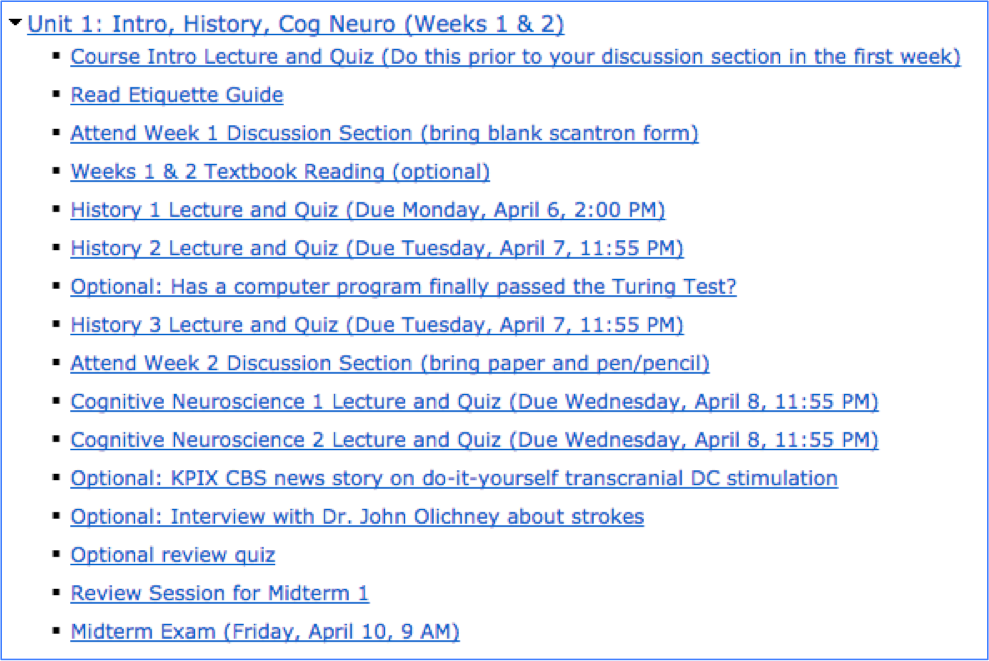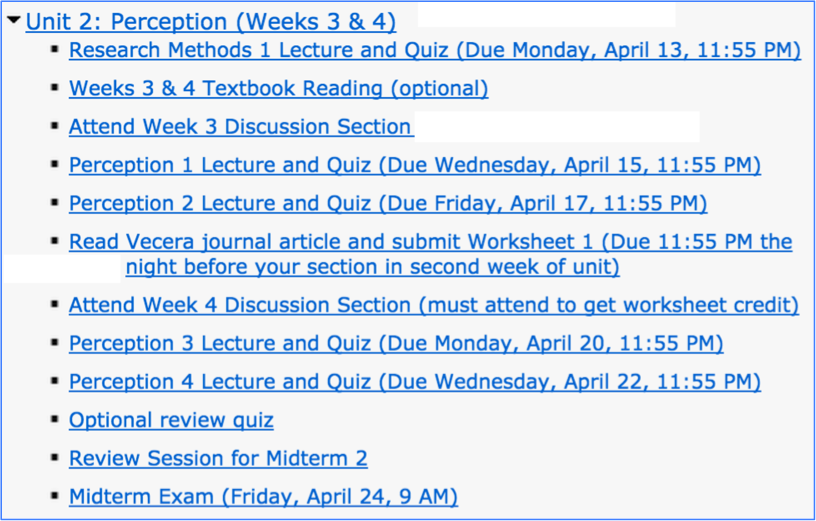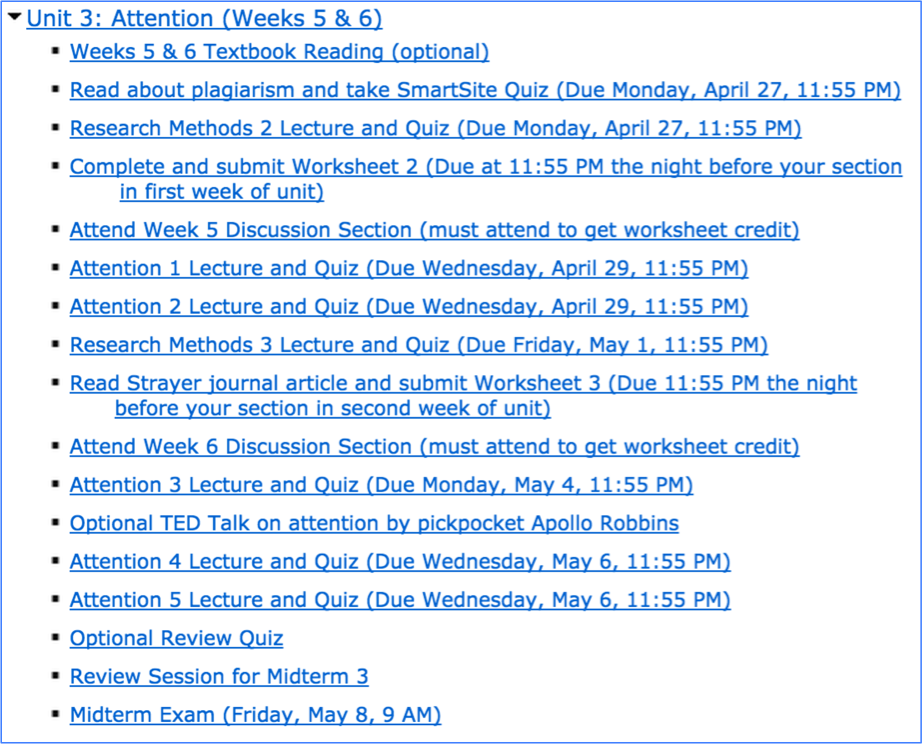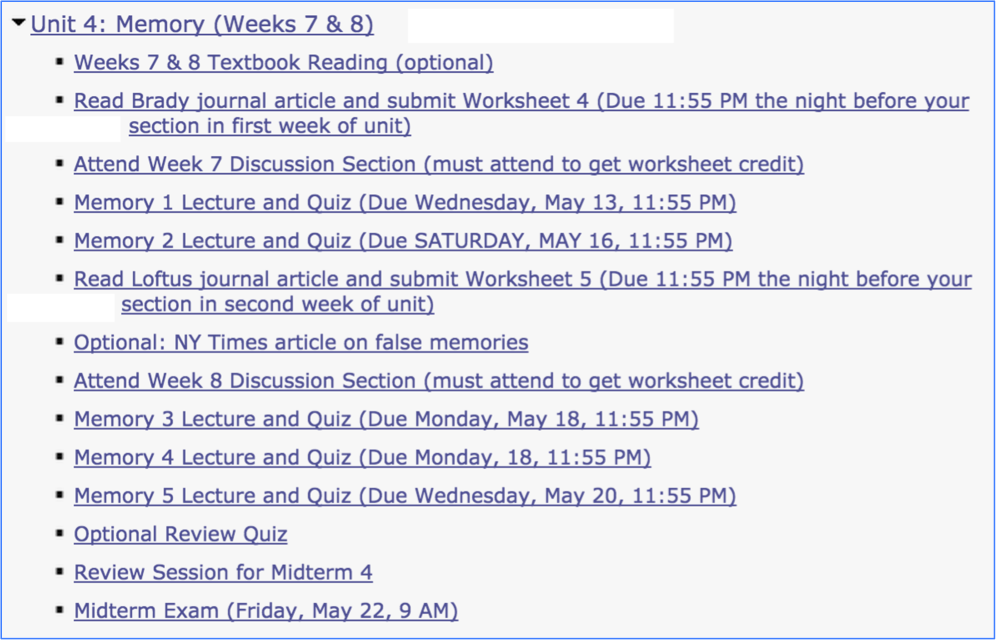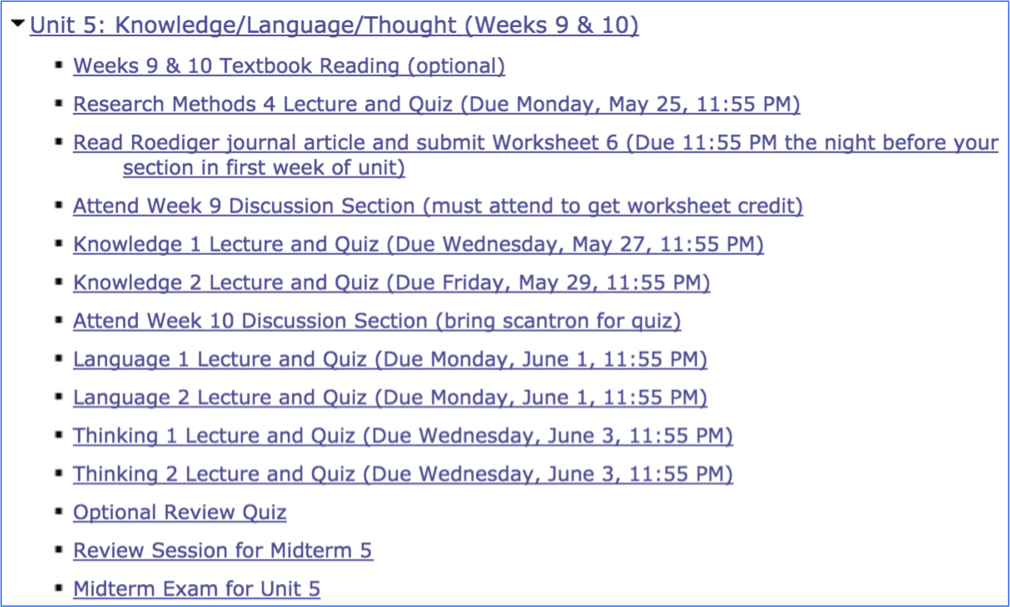end ifUp next: Close-Up View of a Subunit
Students access the course materials via our Learning Management System (LMS), which is called SmartSite (and is a variant on the Sakai LMS). They are guided through each unit, step by step, with the Modules tool. Here’s a screenshot, showing the overall course structure:
Before the Course Begins
Given that this is an unusual course format, it is important to inform the students about the format in advance. We therefore send all enrolled students an email 2-3 weeks in advance that describes the structure and points them to a short video (https://www.youtube.com/watch?v=a86cleJSoPE). The email indicates that they need to have a computer or tablet and a good Internet connection to take the course. In general, frequent emails are essential to the success of a hybrid course, especially in the first few weeks, so that the students are aware of all the components of the course and deadlines. We have a set of emails that are automatically sent to the students at key points in the class.
Unit 1: Introduction, History, and Cognitive Neuroscience
Here’s a screenshot of the expanded Modules Tool for the first unit. It provides a set of links for the various elements of the unit, typically in the order the student should do them. Deadlines are clearly laid out.
Here are descriptions of each element of the unit:
Subunit 1: Course Intro Lecture and Quiz
The lecture material for a given 2-week unit is delivered via a set of subunits, each of which contains short online lecture segments and quizzes. The first subunit lecture introduces them to the course and provides a detailed description of the course format and how to access the course materials. This subunit consists of four 5-minute lecture segments, each of which is followed by an “embedded” quiz question (ungraded). At the end of the subunit, the students take a graded 5-question quiz with a strict deadline. To see how a subunit works, see the Close-Up View of a Subunit, which shows how students access the first subunit of the Memory unit. You can also see an actual example of the video segments and embedded quiz questions from this subunit. If you are wondering how the videos are recorded and then integrated with the quiz questions, see Production of Lecture Videos.
Etiquette Guide
The Etiquette Guide is a text file with hints about how the students should interact in the discussion sections, how they should compose emails to the instructor and TA, and how they should ask and answer questions in the class Facebook group.
Week 1 Discussion Section
This is just a reminder to the students that they need to attend discussion section during this week and that they need to bring a Scantron form (because there is a pre-test during the first week). You can find details of the discussion section activities in the Discussion Sections page.
Textbook Reading
This is a link to a brief page that shows the textbook readings for this unit. Note that the textbook was made optional after the first two times the course was taught.
Subunit 2: History 1 Lecture and Quiz
This lecture/quiz subunit covers the history of psychology prior to the cognitive revolution, from ancient Greece through Behaviorism.
Subunit 3: History 2 Lecture and Quiz
This lecture/quiz subunit covers the engineering and computer science developments of the mid 20th Century that laid the groundwork for the cognitive revolution (e.g., information theory, signal detection theory, Turing machines) and the idea that thinking can be described as computation (including the Turing Test).
Optional: Has a Computer Finally Passed the Turing Test?
This provides links to a press release and commentary in Wired magazine about a recent case in which a computer purportedly passed the Turing Test.
Subunit 4: History 3 Lecture and Quiz
This lecture/quiz subunit describes the basic types of questions and approaches used in cognitive psychology. It introduces a set of core issues that are addressed in each unit of the course:
- Architecture of the human mind
- Limits on human abilities (e.g., speed, capacity)
- Representations (format, persistence)
- Processing Steps / Algorithms
- Hardware (cognitive neuroscience)
- Differences among healthy individuals, across development, and in disorders
- Real-world applications
The subunit lecture ends with examples of my own research on visual working memory that address each of these issues. In addition, every 2-week unit ends with a lecture that reviews how each of these issues was addressed by the research described in that unit. The goal is for the students to see how the varied topics of cognitive psychology are linked together by a common set of questions and how they are relevant for the real world. An example (from the Attention unit) can be seen here.
Week 2 Discussion Section
This is just a reminder to the students that they need to attend discussion section. You can find details of the discussion section activities in the Discussion Sections page.
Subunit 5: Cognitive Neuroscience 1 Lecture and Quiz
Although this is a Cognitive Psychology course, concepts and experiments from cognitive neuroscience are sprinkled throughout the course. This subunit lecture/quiz therefore reviews basic aspects of neuroscience (neurons, neural circuits, gross brain anatomy, and the organization of the visual system).
Subunit 6: Cognitive Neuroscience 2 Lecture and Quiz
This subunit lecture/quiz covers the main methods of cognitive neuroscience (lesions, stimulation, single-unit recording, structural and functional MRI, ERPs).
Optional: KPIX CBS news story on do-it-yourself transcranial DC stimulation
This is a link to an optional TV news segment that is related to the preceding lecture.
Optional: Interview with Dr. John Olichney about strokes
The subunit on cognitive neuroscience methods discusses how strokes lead to lesions, and many of our students are interested in knowing more about this. We therefore shot this interview with a neurologist, Dr. John Olichney, in which he describes the causes and consequences of strokes and stresses the importance of rapid hospitalization of anyone who appears to be having a stroke.
Optional review quiz
At the end of each unit (right before the midterm exam), a “review quiz” is made available that contains all of the quiz questions that the students had received earlier in the unit. This was actually requested by the students the first time the course was taught, and approximately 50% of the students take these review quizzes. The scores do not contribute to the students’ grades. The review quiz for a unit is not made available until after the deadlines have passed for all of the subunit lectures/quizzes of that unit.
Review Session for Midterm 1
The TA leads a live 90-minute review session the night before each midterm. The TA has all of the PowerPoint slides available but does not give a formal presentation. The students are told to come with questions (or to simply circle slides in the lecture notes that they did not understand and ask the TA to go through those slides).
Midterm Exam
All the students meet together in a large lecture hall to take each midterm exam. At UC Davis, many lecture classes meet on Mondays and Wednesdays or Tuesdays and Thursdays, so it’s easy to reserve a lecture hall on Fridays. For details of the exams, see the section on Exams and Grading.
Unit 2: Perception
Here’s a screenshot of the expanded Modules Tool for this unit.
This is organized much like the previous unit, but with a few key differences:
- The Research Methods 1 Lecture and Quiz provides students with a review of statistics and research methods that they will need for their discussion sections and is not related to the topic of this unit
- They read a journal article and complete a worksheet prior to attending the discussion section in the second week of the unit. Details are provided in the Discussion Sections Note that attendance is not required in the discussion sections, but the students must attend to get credit for their worksheets. To keep things from getting overly complicated, students register for a specific discussion section and must attend that section to get worksheet credit.
- The last lecture segment of the Perception 4 subunit describes how the material that was covered in this unit is related to the set of general issues described in the History 3 subunit in the first part of the class.
Unit 3: Attention
Here’s a screenshot of the expanded Modules Tool for this unit.
Some notes about this unit:
- As in Unit 2, there is a Research Methods 2 Lecture and Quiz that provides students with a review of statistics and research methods that they will need for their discussion sections and is not related to the topic of this unit
- They use the information from the Research Methods lecture to fill out a worksheet on statistics (main effects and interactions) prior to the discussion section in the first week of this unit.
- They have a journal article and related worksheet for the discussion section in the second week of the unit.
- There is an optional TED Talk that provides a great example of how attention can fail in the real world.
- As usual, the last lecture segment of the last subunit describes how the material that was covered in this unit is related to the set of general issues described in the History 3 subunit in the first part of the class. You can see this lecture segment here.
Unit 4: Memory
Here’s a screenshot of the expanded Modules Tool for this unit.
Some notes about this unit:
- The students have a journal article and related worksheet for both discussion sections in this unit.
- There is an optional NY Times article on false memories that helps link this unit to current events.
- As in the previous units, the last lecture segment of the last subunit describes how the material that was covered in this unit is related to the set of general issues described in the History 3 subunit in the first part of the class.
Unit 5: Language, Knowledge, and Thinking
Here’s a screenshot of the expanded Modules Tool for this unit.
Some notes about this unit:
- The students have a journal article and related worksheet for the first discussion section in this unit. In the second discussion section, they take a post-test to evaluate how much they have learned relative to the pre-test.
- As in the previous units, the last lecture segment of the last subunit describes how the material that was covered in this unit is related to the set of general issues described in the History 3 subunit in the first part of the class.
Final Exam
There is a cumulative, multiple-choice final exam at the end of the course (see Exams and Grading for details).
Up next: Close-Up View of a Subunit

